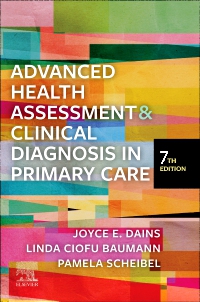
Advanced Health Assessment & Clinical Diagnosis in Primary Care, 7th Edition
Paperback

Take your students to the next step in health assessment! Advanced Health Assessment and Clinical Diagnosis in Primary Care, 7th Edition goes beyond the basic physical examination to help students learn to evaluate and diagnose common conditions. Organized by patient symptoms or complaints, the book follows a systematic approach beginning with a chief concern rather than a specific diagnosis or disease entity, then guides students step-by-step through a diagnostic reasoning process to lead to a clinical diagnosis. This edition includes new chapters on veterans’ health and on contemporary approaches in primary care settings, as well as updated content on issues such as race, ethnicity, and gender identity. An AJN award-winning text, this book helps your students learn to think like expert clinicians.
-
- NEW! Updated content throughout reflects the latest evidence-based approaches to clinical diagnosis and diagnostic reasoning
- NEW and UNIQUE! Contemporary Approaches in Primary Care Settings chapter applies public health principles to primary care in the era of COVID-19, and also includes coverage of telehealth/telemedicine, screenings, immunizations, epidemics and pandemics, health promotion, basic epidemiological terminology, and the cultural-spiritual-holistic context of primary care
- NEW! Updated content on race, ethnicity, sexual orientation, and gender identity includes special sensitivity to healthcare inequality related to social determinants of health
- NEW and UNIQUE! Veterans' Health chapter covers the health concerns of veterans, such as military sexual trauma (MST) and hazardous exposures
- NEW and UNIQUE! Scrotal Pain and Masses chapter addresses this common problem seen in primary care settings
- UNIQUE! Care of Transgender and Gender-Diverse (TGD) Patients chapter equips students with the necessary knowledge to properly assess and care for this underserved patient population
- NEW! Updated Evidence-Based Practice boxes summarize the latest scientific literature related to the diagnosis of patient problems
- Clear, consistent diagnostic reasoning process takes students to the next step of health assessment — beyond basic history and physical examination to diagnostic reasoning and clinical diagnosis
- Diagnostic Reasoning: Focused History sections use "self-questions" to walk students through the thinking process involved in obtaining a pertinent, relevant, problem-specific history that will assist in differential diagnosis
- Diagnostic Reasoning: Focused Physical Examination sections explain how to perform more advanced diagnostic techniques and interpret the findings
- Key Questions guide students through assessment and toward an accurate diagnosis by listing questions to ask the patient, followed by explanations of what the patient's responses might signify
- Laboratory and Diagnostic Studies sections outline the types of tests that might be appropriate based on the focused history and focused physical examination
- Differential Diagnosis sections offer the most common diagnoses for each patient problem and summarize the history and physical examination findings, along with recommended laboratory and diagnostic studies
- Differential Diagnosis tables provide a quick-reference summary of possible diagnoses for each patient problem
- Content on pediatrics is integrated throughout to give a true lifespan focus
- Information on screening for abuse and sexual assault helps in identifying patients who might need additional support or intervention
- Evidence-Based Clinical Practice Guidelines chapter helps students learn to screen for common asymptomatic conditions and promote wellness
- Information on screening for abuse and sexual assault helps identify patients who might need additional support or intervention
- List of Chapters by Body System inside the front cover provides an alternate means of accessing book content
- Compact, convenient size makes it easy to carry this reference in a lab-coat pocket, and colored thumb tabs make it easier for students to find the information they need
- Advanced Practice Nursing (APN) content on advanced assessment serves as a perfect complement to Ball et al.: Seidel’s Guide to Physical Examination and other health assessment textbooks
-
- NEW! Updated content throughout reflects the latest evidence-based approaches to clinical diagnosis and diagnostic reasoning
- NEW and UNIQUE! Contemporary Approaches in Primary Care Settings chapter applies public health principles to primary care in the era of COVID-19, and also includes coverage of telehealth/telemedicine, screenings, immunizations, epidemics and pandemics, health promotion, basic epidemiological terminology, and the cultural-spiritual-holistic context of primary care
- NEW! Updated content on race, ethnicity, sexual orientation, and gender identity includes special sensitivity to healthcare inequality related to social determinants of health
- NEW and UNIQUE! Veterans' Health chapter covers the health concerns of veterans, such as military sexual trauma (MST) and hazardous exposures
- NEW and UNIQUE! Scrotal Pain and Masses chapter addresses this common problem seen in primary care settings
- NEW! Updated Evidence-Based Practice boxes summarize the latest scientific literature related to the diagnosis of patient problems
-
PART I AN INTRODUCTION TO CLINICAL REASONING
1. Clinical Reasoning, Evidence-Based Practice, and Symptom Analysis
2. Evidence-Based Clinical Practice Guidelines
3. Contemporary Approaches in Primary Care Settings
PART II COMMON SYMPTOMS IN PRIMARY CARE
4. Abdominal Pain
5. Affective Changes
6. Amenorrhea
7. Breast Lumps and Nipple Discharge
8. Breast Pain
9. Chest Pain
10. Confusion in Older Adults
11. Constipation
12. Cough
13. Diarrhea
14. Dizziness
15. Dyspnea
16. Earache
17. Fatigue
18. Fever
19. Genitourinary Problems in Patients With a Penis or Prostate Gland
20. Headache
21. Heartburn and Indigestion
22. Hoarseness
23. Limb Pain: Lower Extremity
24. Limb Pain: Upper Extremity
25. Low Back Pain
26. Nasal Symptoms and Sinus Congestion
27. Palpitations
28. Penile Discharge
29. Rashes and Skin Lesions
30. Rectal Pain, Itching, and Bleeding
31. Red Eye
32. Scrotal Pain and Masses
33. Sleep Problems
34. Sore Throat
35. Syncope
36. Urinary Incontinence
37. Urinary Problems in Patients With a Vagina and Associated Anatomical Structures
38. Vaginal Bleeding
39. Vaginal Discharge and Itching
40. Vision Loss
41. Unintentional Weight Loss or Gain
PART III POPULATION-CENTERED CARE
42. Care of Transgender and Gender-Diverse Patients
43. Veterans’ Health
PART IV DIAGNOSTIC IMAGING
44. Abdominal X-Ray
45. Chest X-Ray


 as described in our
as described in our 